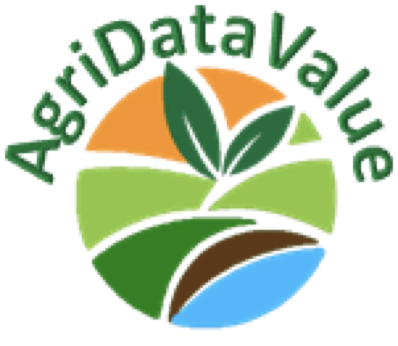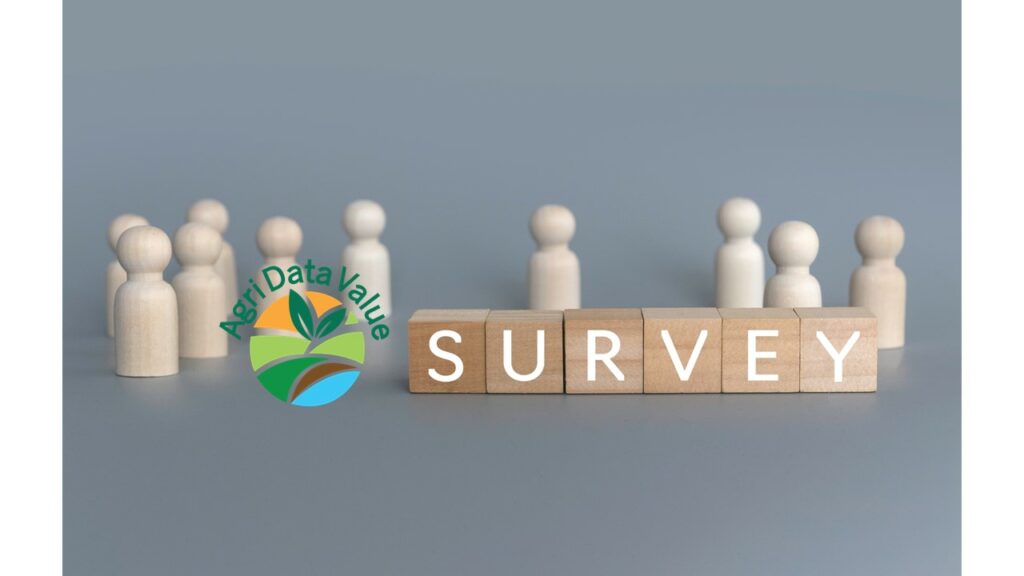In the ongoing transition from conventional to smart farming and precision agriculture, AgriDataValue’s WP1 aims to provide comprehensive insights on how farmers across Europe are engaging with these technologies. For this purpose, a survey destined to Europe’s farmers through the AgriDataValue pilot sites and network was built. The aim of the survey was to gather information on the status of awareness and knowledge on smart farming and precision agriculture, perceived benefits, barriers/concerns, implementation considerations and future outlooks. A set of 12 questions was developed and added to the EU Survey platform in 24 languages (https://ec.europa.eu/eusurvey/runner/AgridataValueSurvey). Available languages are: Bulgarian, Czech, Danish, German, Greek, English, Estonian, Finnish, French, Irish, Croatian, Hungarian, Italian, Lithuanian, Latvian, Maltese, Dutch, Polish, Portuguese, Romanian, Spanish, Slovak, Slovene and Swedish. Overall, 444 contributions were collected. The findings of this survey are presented in what follows.


- Sources of Information: Education Matters
The survey reveals distinct preferences in information sources based on educational background. Farmers with a Master’s degree or higher, predominantly rely on online resources (133 respondents) and agricultural publications (126 respondents). This group values reviewed, authoritative sources and structured learning opportunities like conferences and seminars (92 respondents). In contrast, those with a Technical/Agricultural diploma or Bachelor’s degree adopt a more balanced approach, incorporating different corpora including online resources (112 respondents), publications (82 respondents), and practical sources like extension services (55 respondents) and social media (54 respondents).
Farmers with Secondary or Technical education show a strong reliance on online resources (65 respondents) and agricultural events (64 respondents), emphasizing community knowledge and informal networks. Those with Primary education heavily depend on peer networks (13 respondents), with limited use of online resources and formal channels, highlighting potential accessibility constraints or educational background-related challenges. - Perceived Benefits: Experience Shapes Priorities
The survey highlights that farmers with varying years of experience perceive the benefits of smart farming differently. Climate change adaptation and mitigation are top priorities for farmers with 25, 20, 15, 10, and 5 years of experience, reflecting a universal need for resilience and a general awareness on climate change and its impacts. Cost savings and enhanced environmental sustainability are also highly valued across all experience levels, indicating a broad recognition of smart farming’s potential to improve efficiency and sustainability.
Experienced farmers (30 years) particularly value data-driven decision-making and improved resource management, suggesting that these technologies complement their extensive field knowledge. Less experienced farmers (5-10 years) are keen on yield improvement and labour reduction, aligning with their need to establish productive and efficient operations somewhat under an economic/profit point of view. - Barriers to Adoption: Financial and Technical Hurdles
Despite the promising benefits, according to responders, several barriers hinder the widespread adoption of smart farming. High initial investment costs are the most significant barrier, cited by both familiar (218 respondents) and unfamiliar (133 respondents) participants, hence underlining again the weight of economic considerations. Limited access to financing options and lack of technical knowledge are also major concerns, highlighting the need for financial support and educational initiatives.
Farmers familiar with smart farming are more aware of detailed challenges, such as lack of institutional support and technology customization limitations. In contrast, those unfamiliar with the concept show a relatively lower perception of barriers, indicating a potential gap in awareness and understanding. The latter can be considered as the easiest barrier as education and knowledge spreading can contribute to bridging these gaps. - Detailed Insights: Benefits and Barriers by Farming Type
The survey also provides a detailed breakdown of perceived benefits and barriers based on the type of farming practiced:
o Crop Farming: Farmers engaged in crop farming see significant benefits in climate change adaptation (124 respondents), cost savings (184 respondents), and enhanced pest and disease control (147 respondents). However, they also face barriers such as high initial investment costs (224 respondents) and lack of technical knowledge (123 respondents).
o Mixed Farming: Mixed farmers value improved resource management (85 respondents) and increased crop yield (85 respondents). Barriers include high initial investment costs (92 respondents) and limited access to financing (67 respondents).
o Livestock Farming: Livestock farmers perceive benefits in enhanced pest and disease control (9 respondents) and improved resource management (14 respondents). Barriers include high initial investment costs (17 respondents) and lack of technical knowledge (7 respondents).
o Viticulture: Farmers in viticulture see benefits in improved data-driven decision-making (9 respondents) and enhanced environmental sustainability (6 respondents). Barriers include high initial investment costs (8 respondents) and lack of reliable internet connectivity (3 respondents).
o Other Niche Farming: These farmers value increased crop yield and productivity (6 respondents) and improved resource management (2 respondents). Barriers include high initial investment costs and limited availability of suitable technologies. - Influencing Factors: What Drives Adoption?
Financial incentives and subsidies are the strongest motivators for adopting smart farming, especially among those facing high investment costs. The availability of affordable and reliable technologies, access to training and technical support, and demonstrated success stories from other farmers also play crucial roles in influencing adoption decisions.
Interestingly, participants who prioritize data security and privacy are more cautious, reflecting a need for reassurance about the safety of their information particularly for large-scale industrial farmers. This aspect highlights the importance of addressing data concerns to foster trust and encourage adoption. - Gender and Education: Shifting Dynamics
The survey also sheds light on gender representation and educational attainment in agriculture. While male participants dominate across all age groups, female representation is highest among the youngest farmers (18-25 years), suggesting a positive trend towards gender inclusivity particularly for upcoming farmers. Education levels vary, with a notable presence of advanced degrees among male participants, while female participants are more represented in technical and secondary education according to the survey’s responders. - Pathways to Progress: Overcoming Barriers and Enhancing Adoption
To fully harness the potential of smart farming, it is essential to address the identified barriers and leverage the factors that drive adoption. Some recommendations are proposed below:
o Financial Support and Incentives: Governments and institutions should provide more financial incentives, subsidies, and accessible financing options to lower the initial investment barrier. This support can encourage more farmers to adopt smart farming technologies.
o Training and Technical Support: Establishing comprehensive training programs and technical support services can help bridge the knowledge gap. These initiatives should focus on practical, hands-on training to build confidence and competence in using smart farming tools.
o Success Stories and Demonstrations: Sharing success stories and conducting demonstrations can showcase the tangible benefits of smart farming. Peer-to-peer learning and examples from successful initiatives like AgriDataValue can inspire and motivate farmers to embrace new technologies.
o Policy and Institutional Support: Developing favorable policies and strengthening institutional support can create an enabling environment for smart farming. This includes ensuring access to reliable internet connectivity and addressing concerns about data security and privacy.
o Inclusive and Accessible Solutions: Tailoring smart farming solutions to be inclusive and accessible for farmers with varying educational backgrounds and experience levels is crucial. This approach can help ensure that all farmers, regardless of their starting point, can benefit from these technologies.
Conclusion: Pathways to Progress
The AgridataValue Survey underscores the transformative potential of smart farming and precision agriculture. By addressing financial and technical barriers, providing robust support systems, and fostering an inclusive environment, the full potential of these technologies can be unlocked. As AgriDataValue moves forward, leveraging insights and findings to shape policies and initiatives that support farmers in their journey towards a sustainable and efficient agricultural future.


